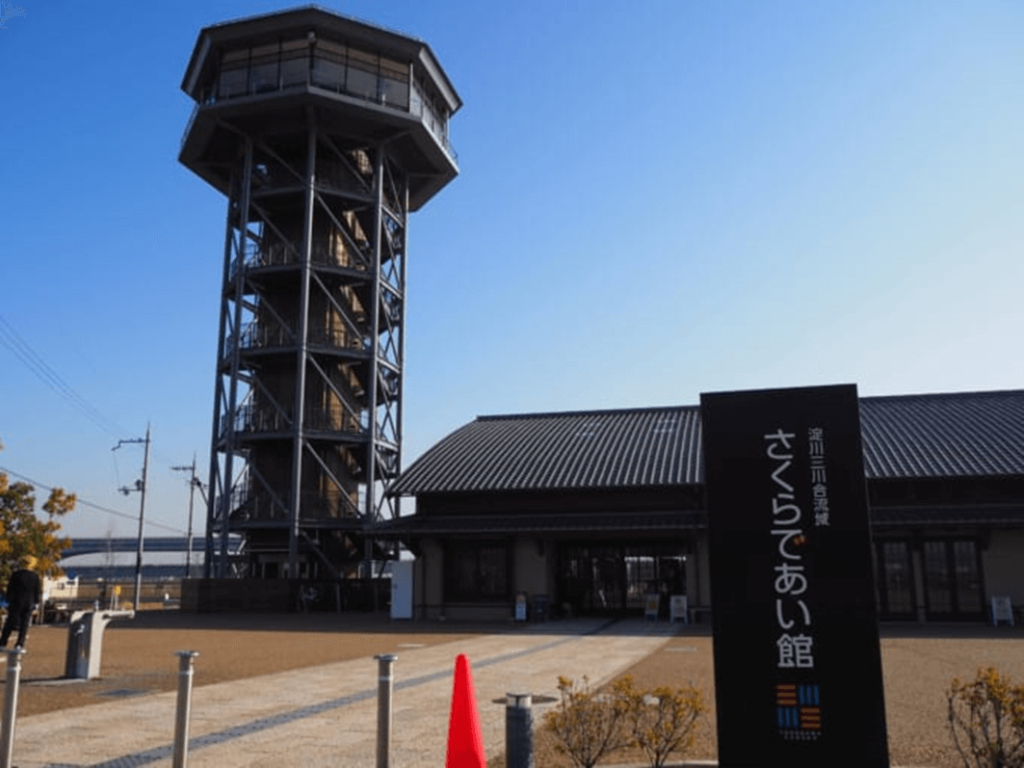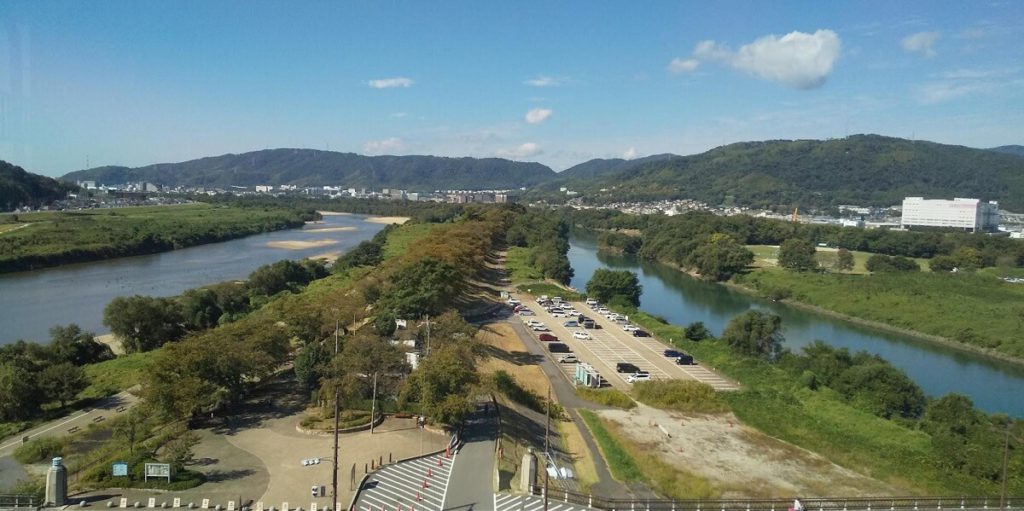In the Kansai region, Osaka and Kyoto are well known cities that many tourists visit. However, have you ever heard of Yawata City? It is located in the middle of the Keihan Railway, halfway between Osaka and Kyoto, away from the hustle and bustle of both major cities. If you prefer a place with fewer people, why don’t you stop by at Iwashimizu-Hachimangu (Shrine) Station (石清水八幡宮駅)? Today, I would like to introduce some places worth visiting, including some hidden spots in Yawata City.
Sakura-deai Visitor Center (さくらであい館)

Yawata is the place where three big rivers, the Kizu (木津川), the Uji (宇治川), and the Katsura (桂川), meet and form one great river, the Yodo River (淀川), which flows into Osaka Bay. This dynamic point of nature is so wide that only a bird can see it. Don’t worry, though, because there is a 25-meter observation tower at the Sakura-deai Visitor Center (さくらであい館) on the river bank, which offers a 360-degree view of the area. This area is also famous for its cherry blossom spot called “Sewari-tei”(背割堤), where a row of cherry trees stretches for 1.4 km. Needless to say, the area is filled with people when the cherry trees are in full bloom. In addition, the Sakura-deai Visitor Center is a convenient rest spot for cyclists who use cycling paths along the river. Bicycles can be rented at the tourist information center next to Iwashimizu-Hachimangu (Shrine) Station. You can also get a guide map there.


From the view of the observation deck
Sakura-deai Visitor Center | Confluence of the three rivers forming the Yodogawa River Sakura-deai Visitor Center (yodogawa-park.jp)
https://www.yodogawa-park.jp/sansen/en/
Flow Bridge (流れ橋 Nagare-bashi)
Next, I would like to introduce you to one of the hidden gems, the Nagare-bashi bridge (流れ橋). It is recommended to go cycling there via “Kizu Cycling Road“. Nagare-bashi is directly translated as “flow bridge.” It is officially called Kouzuya-bashi (上津屋橋), one of the longest wooden bridges in Japan, at 356.5 meters long and 3.3 meters wide. Why is it called “Nagare-bashi“? When the river level reaches the bridge, the bridge planks are designed to flow in order to reduce water resistance. When the water recedes, the bridge planks, connected by wire ropes, are pulled up and placed back on the bridge piers. In fact, the bridge has been washed away 23 times so far and fixed again each time.
As the bridge blends in with the surrounding nature and tea plantations, the scenery is registered as a Japan Heritage Site. Also, it has been used many times as a filming location for period dramas. The bridge has no parapet, so crossing it can be a bit intimidating. Why don’t you cross the bridge as if you were a samurai? Near the Nagare-bashi bridge, there is a facility called “Shikisai-kan” (四季彩館), which offers fresh vegetables, souvenirs, restaurants, and accommodations.

やわた流れ橋交流プラザ 四季彩館 (shikisaikan.co.jp)
http://www.shikisaikan.co.jp/
Iwashimizu Hachimangu (石清水八幡宮)

Next, I would like to mention Iwashimizu Hachimangu, which is also the name of the station that was renamed from Yawata City in 2019. This shrine has several majestic and precious architectural structures designated as national treasures. The spacious and peaceful precincts of the shrine are worth exploring. The main shrine is located at the top of the hill, Otokoyama (男山), which can be reached by a 3-minute cable car ride or climbing on foot if you have the energy. The grove of trees surrounding the shrine is considered sacred and believed to be inhabited by many deities. Now, rather than getting into the details of the shrine’s history, I would like to talk about a little-known interesting fact.
There is probably no one who does not know the famous inventor, Thomas Edison. In fact, one of his inventions, the light bulb, has a deep connection to Yawata City. He made the first practical application of the incandescent light bulb at the end of the 19th century. He initially had great difficulty in finding a suitable material for the filament. After he tried thousands of options, from metals to cotton thread, he found out that bamboo was promising. So, then he collected bamboo from all over the world and concluded that the bamboo from the grove near Iwashimizu Hachimangu Shrine produced the most durable, long-lasting, and reliable light bulb. There is a monument on the grounds of the shrine to commemorate Edison and his achievement.

Shokado Garden (松花堂庭園)

Finally, I’d like to show you one more hidden gem. It’s the Japanese Garden called Shokado (松花堂). The inner section of the garden is a designated National Palace of Scenic Beauty. The garden is named after a Buddhist monk, Shokado Shojo (松花堂昭乗)(1584~1639). He was a prominent tea master and artist who loved hosting tea gatherings in his teahouse. In the outer garden surrounding the inner garden, there are three authentic tea houses of different styles, where tea ceremonies which are open to everyone are held regularly. These houses are integrated into the lush landscape. The spacious garden offers a wide variety of plants, such as 400 species of bamboo, about 300 camellia bushes, maple trees, and many other plants, ensuring that there is something in season to enjoy year-round. If you find a Suikinkutsu (水琴窟), the photo below, put your ear close to the tip of the bamboo. You will hear the beautiful sound of dripping water resonating in the bamboo.





Adjacent to the Shokado garden is “Kyoto Kitcho” (吉兆), a renowned restaurant specializing in fine Japanese cuisine. One of the items on the menu, “Shokado-bento” (松花堂弁当), is now well-known as a square meal box in Japan, which is cross-partitioned. It originated from the lacquer box used by Shokado Shojo as his toolbox. The founder of Kitcho was inspired by it and created it as a meal box. You can enjoy exquisite dishes while admiring the beautiful Japanese garden.

(Note)
The inner section of the garden containing Shojo’s thatched-roof hermitage and the guest hall of his retirement temple is currently being repaired because of the damage by the major typhoon in 2018.
SHOKADO Garden Art Museum
https://shokado-garden-art-museum.jp/
Conclusion
As I write this article, it is the fall of 2022. Autumn is the most suitable season for cycling as well as walking and hiking. Why not go cycling starting from “Sakura-deai Visitor Center”? Cycling paths have been developed along the Katsura, Kizu, and Yodo Rivers, leading to Kyoto, Nara, and Osaka, respectively. In order to get to Nagare-bashi or Shokado, you can take a bus or taxi at Iwashimizu-Hachimangu Station, and you can also rent a bicycle for 500 yen per ride. Bicycles can be left at either location. I hope you can enjoy exploring Yawata City feeling the wind from the river and nature surrounding the historical spots.


3-mitute walk south from Iwashimizu-Hachimanngu Station
Lives in Takatsuki city, Osaka. Has been engaged in English for work and fun for years.





 HTJ has a YouTube page! Check it out
HTJ has a YouTube page! Check it out
Hi Mami!
I always enjoy your article.
I’m interested in the bridges.
Angobashi and Nagarebashi look so good with Edo vibes, but I’m afraid of heights.. I think I can’t cross the bridge like a samurai. xD
Also, I didn’t know that Japanese bamboo helped Edison.
Thank you for helping me deepening my knowledge!
Yumi
Hi Yumi! Thank you for reading my article.
Yawata City is my hometown, but there were many things I did not know about it. I am always learning by writing blogs. Are you afraid of heights? If so, let’s hold hands and cross the bridge, Princess Yumi. xD
Mami